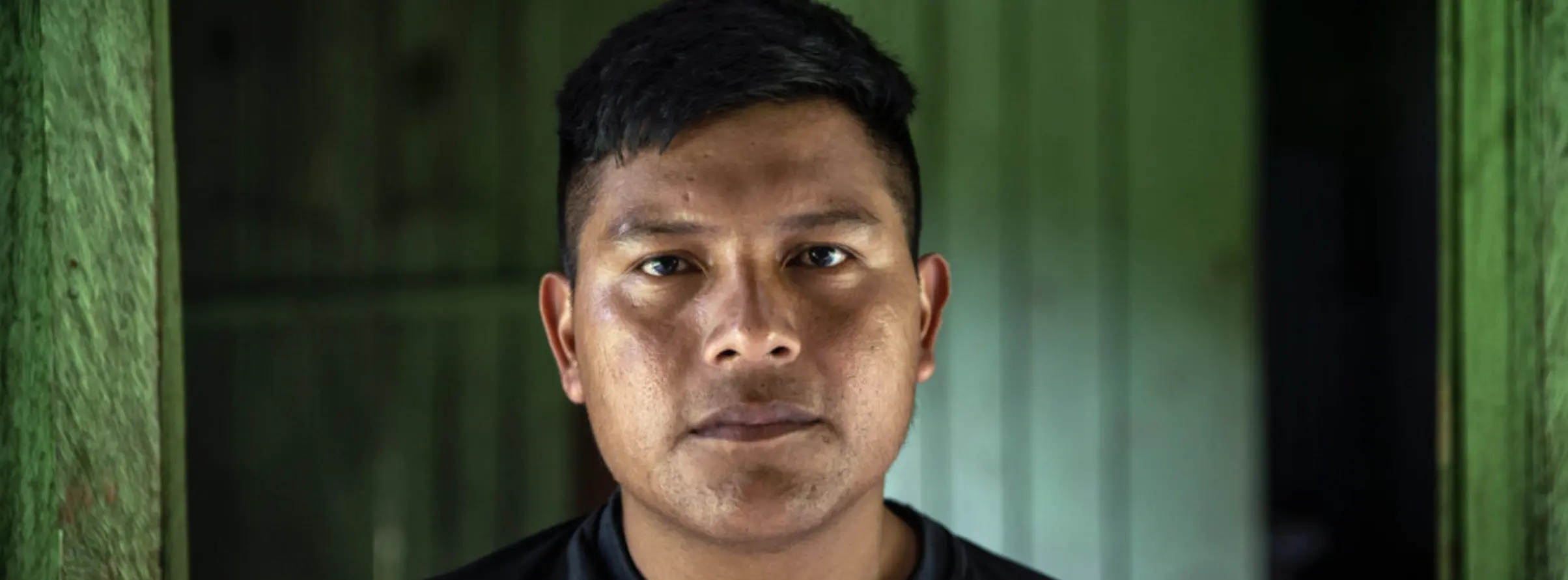
- An increasing number of young Indigenous people in Brazil’s Yanomami Indigenous Territory are leaving their communities behind and turning to illegal gold mining, lured by the promise of small fortunes and a new lifestyle.
- Work in the mining camps ranges from digging and removing tree roots to operating as boat pilots ferrying gold, supplies, and miners to and from the camps; recruits receive nearly $1,000 per boat trip.
- The structures, traditions and health of Indigenous societies are torn apart by the proximity of the gold miners, and the outflow of the young generation further fuels this vicious cycle, say Indigenous leaders.
- Amid the COVID-19 pandemic and a lack of authorities monitoring the area, illegal mining in the region has increased drastically, with 20,000 miners now operating illegally in the territory.
WAIKAS, Brazil—From up above, long, massive, yellowish stains tear apart the green blanket of the Amazon. In the northern part of the Yanomami Indigenous Territory near Brazil’s border with Venezuela, these illegal gold mines, known locally as garimpos, blanket the banks of the Uraricoera River.
The pilot flies his Cessna aircraft low but doesn’t get too close. He fears the armed garimpeiros, or gold diggers, on the ground as much as the other small planes swooping through the tree canopy to avoid the police radars and supply the mining camps.
On the ground, the Indigenous village of Waikas is in sight. This is home to the Yek’wana, one of the eight ethnic groups who live in this territory the size of Portugal.
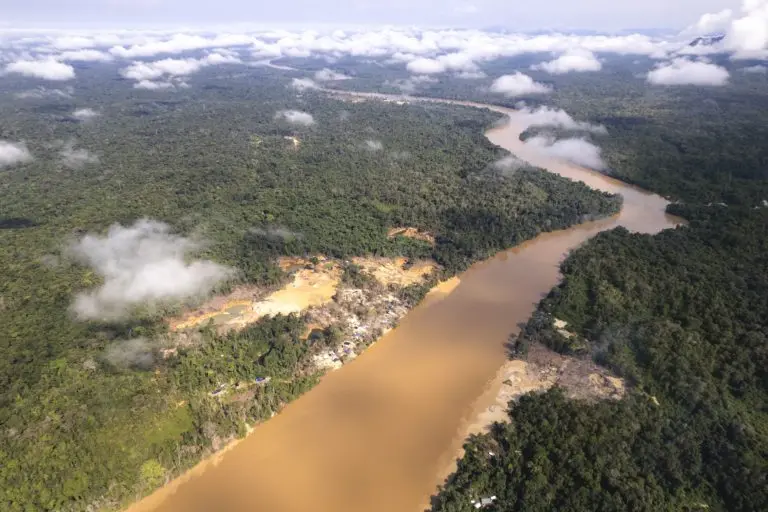

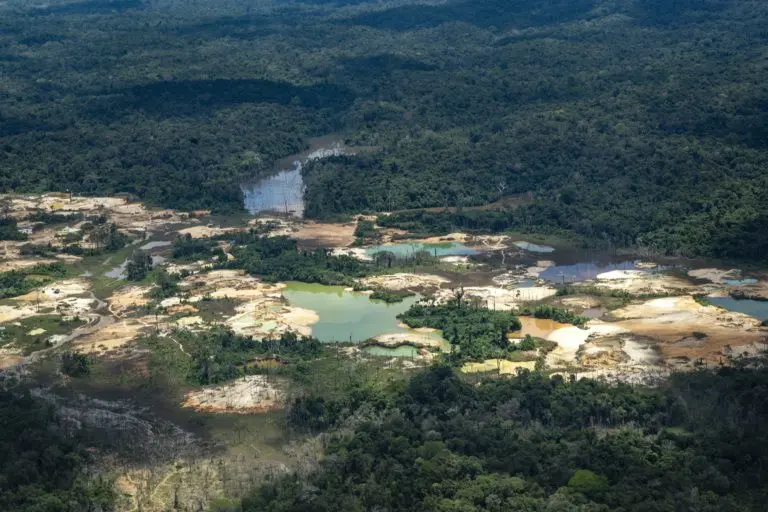
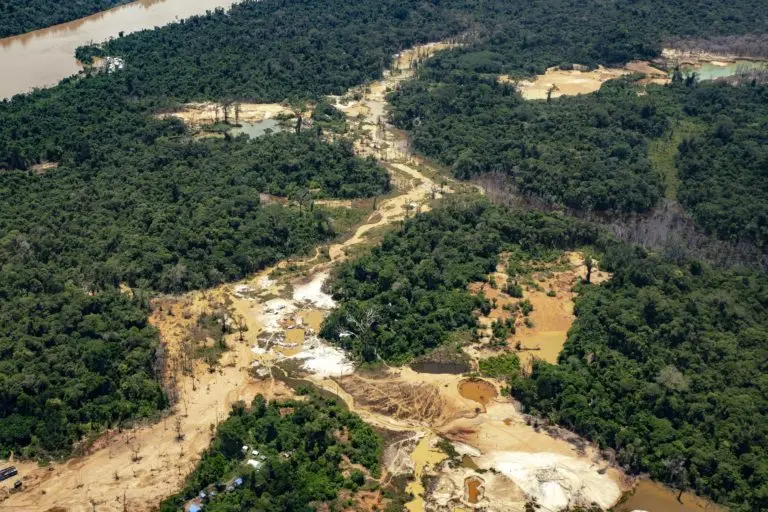
“Illegal mining, the garimpo, has destroyed everything. Our river has become muddy and contaminated. We can’t fish anymore, and the animals have fled far away from the noise of the [mining] generators and machines,” says Julio Yek’wana, one of the community’s leaders in Brazil’s Roraima state. There are currently around 20,000 illegal miners in the Indigenous territory, according to the Federal Public Ministry. Deep inside the forest, the boat traffic carrying men and supplies to the garimpos is relentless.
The entire structure of Julio’s society has been shaken to its foundation, he tells Mongabay.
Illegal mining and the fortunes promised by gold miners is swaying Indigenous youth in the village. An increasing number of members of the next generation are turning away from their roles in protecting their ancestral forests and turning toward illegal mining. This is mainly due to lack of other economic opportunities and the disintegration of traditional society, says Mauricio Yek’wana, one of the directors of the Hutukara Yanomami Association, an Indigenous organization based in the Roraima state capital, Boa Vista.
“Before, illegal miners only focused on the leaders, but in the last 10 years, they started preying on the youth, easier to bait into working in the garimpo,” Mauricio says. The proximity between the garimpeiros and the Yek’wana community worries him.
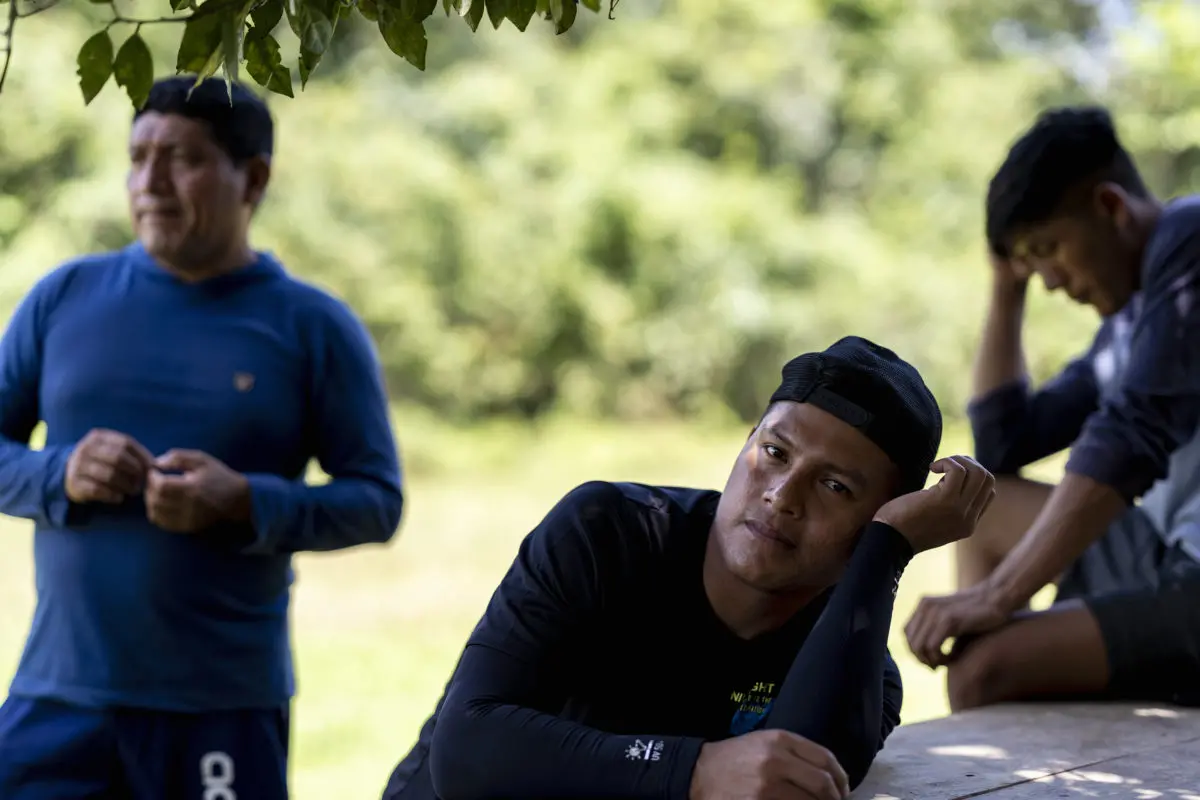
A small fortune, promises and temptation
Robervaldo, 26, was one of these recruits. He worked for the gold miners for two years. “First, they approach you being very friendly, offering stacks of banknotes, cellphones or alcohol,” he tells Mongabay.
Some are poorly paid and have to front a large sum just for the trip to the mining camp, while others make a decent amount of money, only to spend their earnings at the mining site. Everything is available in the garimpos: alcohol, drugs, food, even internet access. The garimpeiros first used the internet to communicate with other miners to warn of upcoming police raids. But they soon discovered that it was also a great tool to attract young Indigenous people to the camps. In the Indigenous villages, by contrast, internet connectivity is rare and far between.
Alberto, who comes from another group in Roraima, also works in a garimpo. At 28 years old and with several stints in the mines, he’s considered an elder by the Indigenous teenagers working in the camps. He volunteered to go on his own.
“Money is the first and the main motivation, but the garimpo is also a very animated place! Under a tent, on a boat, there are brothels everywhere. Musicians come from the city to play every night in the camp. Sometimes, even famous people arrive by plane to play and entertain,” Alberto tells Mongabay.


Along the Uraricoera River, tents, floating restaurants, bars and brothels break the monotonous green wall of trees that line its banks. A 40-minute boat trip from Waikas, a massive camp appears on both shores. Giant sieves built on scaffolding-like structures separate the gold from the earth and then agglomerate it with the help of toxic mercury.
This mercury then sinks into the river, contaminates the water and is consumed by the fish like the piraiba (Brachyplatystoma filamentosum), the pescado dourado (Salminus spp.), and tucunaré (Cichla spp.). It works its way up the entire food chain and into the Indigenous communities that eat the fish and drink from and bathe in the river water.
The Oswaldo Cruz Foundation, Brazil’s leading public health research institute, carried out research in 2016 that showed that 92% of Yanomami individuals tested had higher levels of mercury in their blood than deemed safe by the World Health Organization (WHO). High exposure to mercury can lead to severe neurological abnormalities, premature births and birth defects. The residents of Waikas now refuse to fish.
Out of the 200 people living in village, around 10 are youths working for the illegal miners and facilitating the contamination of their communities’ waters. There’s no lack of work in the camp: digging and washing the earth with high-pressure hoses, working the pumps, and removing large tree roots are just some of the main chores given to the young recruits.
Two of the youngsters from the Waikas community are employed for these physical tasks, but most work as boat pilots. Faced with the treacherous currents and insidious rocks and floating branches of the river, the garimpeiros appreciate the experience and knowledge that Indigenous people have of the river.
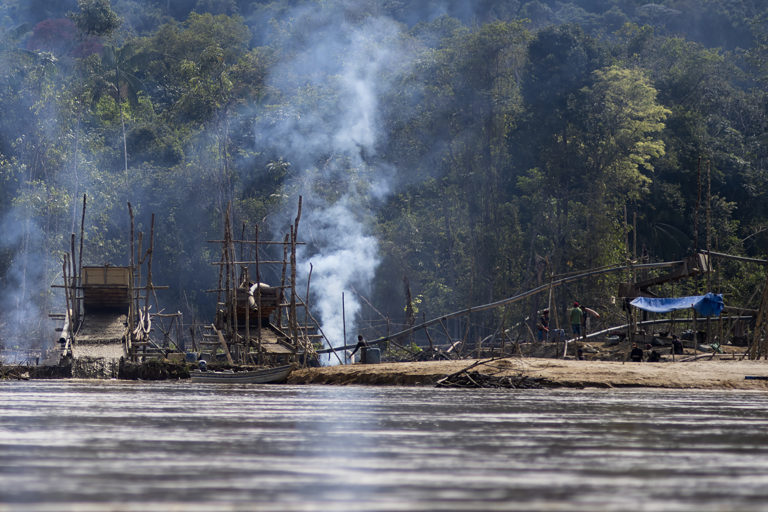
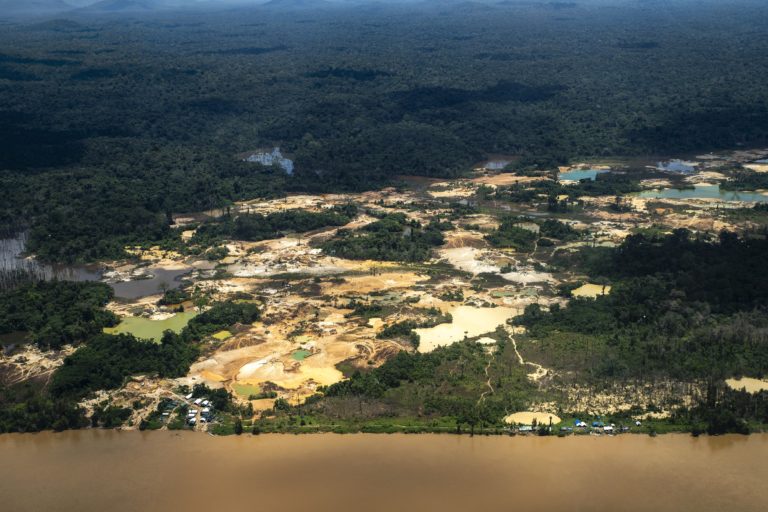
According to Robervaldo, a trip from the one of the base camps outside the Yanomami territory up to a garimpo site inside it, typically taking six to nine days, pays 5,000 reais, or nearly $1,000. It’s a considerable amount of money for the region, but the risks are high. While police raids on garimpos have diminished, the growing presence of gangs has made this the most violent part of the Yanomami territory.
The PCC, or Primeiro Comando de la Capital — a powerful gang from the south of Brazil that’s involved in drug trafficking, racketeering, extortion and, most recently, gold trafficking — has ruled over this part of the territory since 2018.
“Sure, you earn more than in the city, but it’s very tense. Beyond the dangers linked to working in the garimpo, I saw three murders in one month,” Alberto says.
Despite the risks, there are plenty of candidates to join the garimpo, and even more since the COVID-19 pandemic struck. With the pandemic, the skyrocketing price of gold and the favorable political environment, the influence of the garimpos has risen like never before. Between 2020 and 2021, destruction by illegal mining activity increased by 46%.
“Everything stopped except for the garimpo. They gained more planes, more boats, more helicopters and occupied more land,” Mauricio Yek’wana says.
“[And] when you arrive in the garimpo, you have to wait a minimum one month for a spot to be available,” Alberto tells Mongabay.

Alberto returned to his village to see his family and to rest after several weeks of work in the garimpo, but says he wants to leave again soon. He’s one of the few who still return to the village; those who do, often do so temporarily.
Robervaldo, by contrast, stopped working with the garimpeiros for good after going back to school.
“I now try to bring back our youth. But it is impossible to have these kinds of conversations here [in the village]. It is only possible to speak about this in the city,” he says. The weight of tradition, respect for elders, and a social environment where everything is known by the entire community prevents young people in the village from speaking openly about their desires and curiosities. “Even if a few quit the garimpo, they are immediately replaced by others.”
Often, the link between the community and the youngsters is entirely destroyed.
“Little by little, they stop supporting their own, they are manipulated by the gold miners, and they come back to the village drunk and argue with the leaders,” Robervaldo says.
In some garimpos, they’re provided with weapons by the gangs who rule the camp. Weapons, alcohol and the absence of authorities can create a perfect storm for tragic endings, says Herrero, an Indigenous member from the southern part of the territory.
“The consequences of misunderstanding are much more dramatic when the traditional mechanisms of conflict resolution of these societies stop working,” he tells Mongabay.
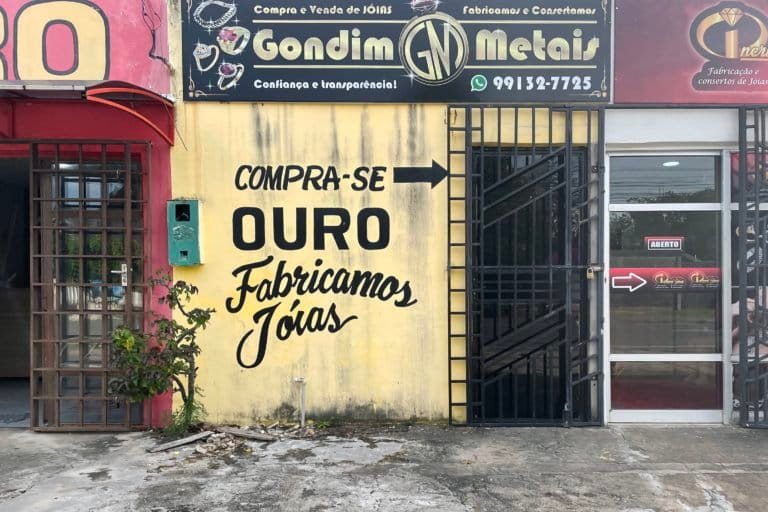
“The presence of a garimpo so close to a community is a guarantee of internal conflicts and the risk [for the community] of disappearing,” says Mauricio Yek’wana. He adds he fears his community will end up splitting and moving elsewhere or being absorbed into another Indigenous community. The disintegration of communities is on many elders’ minds and is already a reality in some regions.
“What is for sure is that this community is disappearing,” says Alisson Marugal, a prosecutor with the Roraima state office of the Federal Public Ministry. He cites the case of Aracaçá, a village close to Waikas. “They were 40 before the settling of the garimpo; they are only 25 left now,” he says.
Among the many crimes associated with the mining camps, Marugal investigated the rape and murder of a young Yanomami girl by a miner in Aracaçá. He was never able to find any evidence. Sex work and sexual exploitation of young Indigenous girls is a pressing issue in communities near the camps. An investigation found that young adults and girls as young as 11 were bribed to stay in tents with miners and offered food, clothes and work material in exchange for sex.
Despite her fears, Utinea, a woman from Waikas, sells fruits and vegetables to the nearby garimpeiros for additional income.
“We always stay in groups. There are too many men there,” she says, without giving any details.

Ehuana Yanomami, one of the rare female leaders in the territory, is more up-front about the situation: “Many exchange sex for food; beyond abusive relations, they can also be incited to drink, and risk being group raped.”
Four young women who were forced into prostitution committed suicide last month in Aracaçá, Marugal says.
A vicious cycle
In several parts of the Yanomami Indigenous Territory, like Xitei and Homoxi, the illegal gold miners have taken over the local health clinics to consolidate their power in a region where the state is largely absent. Yanomami residents still frequent these clinics, and rely on them heavily to deal with the spread of imported diseases caused by the invasion of the miners.
Pools of stagnant water in the garimpos provide prime breeding sites for mosquitoes, leading to outbreaks of malaria. In Waikas, there are no doctors or nurses, just two health technicians who have to cope with up to 10 cases of malaria a week. All the Yek’wana say they have fallen sick in this territory, which currently has the highest number of recorded cases of malaria in Brazil. When ill, people are unable to participate in the community’s tasks and activities such as agriculture or hunting. Consequently, hunger and malnutrition rates begin to rise.
The vicious cycle is self-perpetuating: the community gets weaker, young people leave for the camps, more miners arrive, and the incidence of malaria rises.
“In this new system, the youngsters who works in the garimpos and have access to the goods feel more powerful than the elders. This inspires other young [people] to go work for the garimpo,” Mauricio says.


Junior Hekurari, president of the health council of the Yanomami and Yek’wana (Condisi-YY), says he tries to help as many residents as he can, but is in a desperate position. Because of the lack of access to health care, children die of easily treatable diseases like diarrhea and parasitical worms. Since 2021, more than 9,000 people have lacked access to treatment against intestinal parasites. And as some children vomit out huge worms, the malnutrition cases continue to surge.
Thirty years ago, the death of around 20% of the Yanomami population from diseases brought in by the illegal miners spurred an international mobilization effort to recognize their Indigenous land, now the largest in Brazil. However, illegal gold mining continues to expand unchecked.
In 2021, out of the 400 gold mining areas monitored, only nine were targeted in police raids, says Marugal, the prosecutor.
Trying to stem the tide
In an attempt to counter the attraction of the garimpo to the Indigenous youths, in 2019 the Yek’wana developed an agricultural program called Yanomami Cocoa, to produce organic cocoa for chocolate.
“No need to go to the garimpo or to the city to get money. This is our future,” says Julio Yek’wana as he walks through an orchard of young cocoa trees. “This allows us to preserve the forest and unite the aldeia [village] around a project for the entire community.”
After a first attempt failed to deliver much success, the Yek’wana learned from their agricultural mistakes. They now produce around 400 kilograms (880 pounds) of cocoa beans per harvest once a year. All these have already been sold to buyers.
At around 37 reais per kilo ($7/kg, or $3/lb), cocoa can’t compete with gold. But it has the advantage of offering an economic alternative to Indigenous youths that avoids conflict.

The Palimiú community, a two-hour boat ride upstream from Waikas, decided to replicate the cocoa project there to also protect the community against the dramatic influence of the garimpos. In 2021, the community came under multiple attacks from the garimpeiros that culminated with the killing of their leader in October that year.
“It’s difficult to oppose the garimpeiros directly; they threaten us if we bother them [because] there is no legal [Brazilian] authority here,” says Sebastiao, an elder of the Waikas community.
A great share of the national population, the local elite and politicians, including Jair Bolsonaro, the outgoing president, support the mining industry. In the elections in October that he lost, Bolsonaro still managed to receive the highest number of votes in Roraima. The state’s elected governor, a pro-mining political ally with a similar ideology to Bolsonaro, was reelected in the elections.
The Indigenous leaders of the Yanomami Indigenous Territory say they’re realistic and don’t believe in a miracle following the election of the former president Luiz Inácio Lula da Silva, who promised to combat illegal mining.
However, they say they hold out hope for the support and the means to limit the garimpeiros’ invasion of their territory and to protect their youth. This, they say, could be in the form of cutting the supply chains on which the miners rely for their illegal activity. Though often referred to as artisanal, the mining done here is more industrial in scale, with planes and boats carrying equipment and supplies in and ore out.

“Back bases” located outside the Yanomami territory are essential to the mines, serving as staging points where mining supplies and fresh batches of miners leave for the mines daily. They’re also the starting point for many young Indigenous recruits. Located below a bridge a few dozen kilometers from Boa Vista, on the shores of the Uraricoera River, one such base occupies what used to be a ranger station to tackle illegal invasions of the territory by garimpeiros. The rangers’ mission was terminated in 2017. A court ordered the ranger station to be revived in 2020, but this has not yet happened.
Late one afternoon at the base, pickup trucks arrive and are unloaded. Men and supplies board the up to 16-meter-long (52-foot) boats with powerful engines steered by young Yanomami boys. A couple of burnt and abandoned boats from a past police raid line the opposite shore. They don’t seem to intimidate the young boat pilots on the go.









